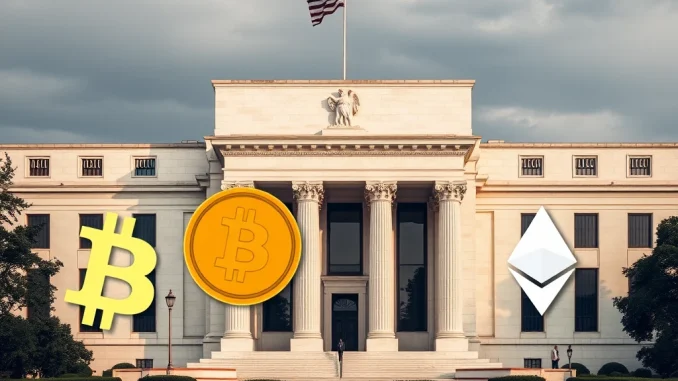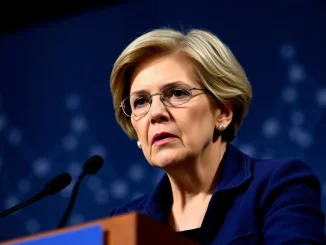
The world of finance is constantly evolving, and nowhere is this more apparent than at the intersection of traditional banking and digital assets. A significant development recently emerged from the heart of the US financial system regarding Federal Reserve crypto oversight. On April 24, the U.S. Federal Reserve announced a pivotal change: it is withdrawing its specific supervisory letters from 2022 and 2023 that mandated state member banks provide advance notice before engaging in crypto and stablecoin-related activities.
Understanding the Federal Reserve Crypto Guidance Shift
Previously, state member banks under the Federal Reserve’s purview faced a unique requirement. They had to notify the Fed well in advance of plans to get involved with crypto assets or stablecoins. This was a precautionary measure, reflecting the regulators’ cautious approach to a rapidly developing and often volatile sector. The rescinded letters effectively created a specific, elevated hurdle for banks looking to innovate or offer services in this space.
The core change is straightforward, yet impactful:
- Old Process: Specific advance notice required for crypto/stablecoin activities based on 2022/2023 guidance letters.
- New Process: Oversight of these activities will now fall under the Federal Reserve’s standard supervisory framework.
This doesn’t mean oversight disappears. It means the *type* and *timing* of that oversight are changing, aligning crypto-related activities more closely with how banks’ other novel or complex activities are supervised.
What This Means for Banks and Crypto Activities
For banks and crypto operations, this move could signal a normalization of digital asset activities within the traditional banking structure. By removing the explicit advance notice requirement, the Fed might be acknowledging a growing understanding of these technologies or perhaps aiming for a more streamlined regulatory approach.
Does this make it easier for banks to engage with crypto? Potentially. It removes a specific, potentially time-consuming, and uncertain step in the process. However, banks are still subject to rigorous safety and soundness standards, as well as compliance with anti-money laundering (AML) and counter-terrorist financing (CFT) regulations. The standard supervisory process is still robust and involves ongoing monitoring, risk assessments, and examinations.
This shift suggests regulators are moving towards integrating crypto oversight into their existing risk management frameworks rather than treating it as an entirely separate, requiring special permission activity. It’s a step that could encourage more traditional financial institutions to explore or expand their involvement in the digital asset space, provided they can manage the associated risks within the standard regulatory expectations.
Stablecoin Guidance and Broader US Crypto Regulation
The withdrawal of specific stablecoin guidance is particularly noteworthy. Stablecoins, digital assets pegged to stable values like the US dollar, are seen by many as a potential bridge between traditional finance and the crypto world. Regulatory clarity for stablecoins has been a major point of discussion in US crypto regulation.
While this Fed action doesn’t constitute a comprehensive stablecoin regulatory framework (which is still being debated in Congress and among other agencies), it does change the immediate supervisory approach for state member banks dealing with them. It places stablecoin activities under the same lens as other banking products and services, requiring banks to demonstrate they can manage liquidity, credit, operational, and other risks effectively under standard examination procedures.
This decision is one piece of a complex and evolving puzzle concerning crypto policy US. Various agencies, including the OCC (Office of the Comptroller of the Currency), FDIC (Federal Deposit Insurance Corporation), SEC (Securities and Exchange Commission), and CFTC (Commodity Futures Trading Commission), all play roles in regulating different aspects of the digital asset ecosystem. The Fed’s move pertains specifically to its oversight of state member banks and indicates a refinement, not a complete overhaul, of its approach.
What’s Next for Crypto Policy US?
The Federal Reserve’s decision signals a maturing regulatory perspective. It moves away from bespoke, potentially burdensome requirements towards integrating digital assets into existing supervisory models. This could be interpreted as a positive step for the industry, suggesting a path towards greater clarity and potentially smoother integration for banks.
However, it’s crucial to remember that regulatory scrutiny remains high. Banks engaging with crypto must still navigate a complex landscape of rules and expectations. The success of this new approach will depend on how effectively the standard supervisory process can identify and mitigate the unique risks posed by digital assets.
Industry participants and observers will be watching closely to see how this change impacts bank behavior and how it fits into the broader development of crypto policy US. Will other regulators follow suit? Will this encourage more banks to enter the space? Only time will tell, but this Federal Reserve crypto decision marks a notable moment in the ongoing dialogue between traditional finance and the digital asset frontier.
In summary, the Federal Reserve’s withdrawal of specific crypto guidance for state member banks represents a significant procedural shift, moving from explicit advance notice to standard supervisory oversight. This change impacts how banks and crypto activities are regulated, particularly regarding stablecoin guidance, and is a key development in the broader landscape of US crypto regulation and crypto policy US. While potentially streamlining processes for banks, it maintains rigorous oversight under existing frameworks, highlighting the continued importance of risk management in the digital asset space.



